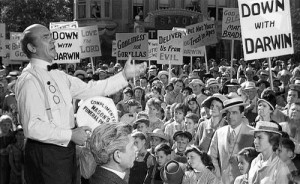Sara Carreras Inherit the Wind Response
In lieu of reading the play, I watched the 1960 film version of Jerome Lawrence and Robert E. Lee’s Inherit the Wind, directed by Stanley Kramer. My first impression of the movie was that for such an old movie (in my millennial opinion), the content was surprisingly modern in nature. The issue of teaching evolution in schools versus teaching creationism is still debated today and I honestly do not think that the issue will be settled any time soon.
While perhaps not the most nuanced, I was interested in how the film characterized the town and its inhabitants. Mob mentality had a sizable presence in the town, and the protesting and yelling only seemed to make the crowd grow angrier, suggesting a lack of freethinking in Hillsboro—the kind of lacking that deemed Bert Cates public enemy number one. The town seemed to be motivated primarily by anger and fear. Perhaps the townspeople were insecure about their beliefs, Cates’ radical thinking putting their own faith on trial, and they acted accordingly. With a belief system that has worked for their community for so many years, that was “good enough for Daniel,” why change it? This fear of change is the town’s driving force, and makes for high stakes in its fight against what Bert believes is intellectual freedom.
 Visually, I thought that the film was stunning. I felt that the director and/or scenic designers were very successful in making choices that helped tell the story. My favorite visuals from the movie were the signage. All of the signs that the townspeople held were very clear and easy to read, and made bold statements. The fans were also interesting because they had “Compliments of Mason’s funeral parlor” written on them, which demonstrated the town’s vast interest in the case. Also notable was the way that heat was portrayed in the courtroom as a tool to illustrate physically the tension in the room. Sweat drops were very large and extremely visible upon the heads of the lawyers and fans were constantly moving back and forth all throughout the room.
Visually, I thought that the film was stunning. I felt that the director and/or scenic designers were very successful in making choices that helped tell the story. My favorite visuals from the movie were the signage. All of the signs that the townspeople held were very clear and easy to read, and made bold statements. The fans were also interesting because they had “Compliments of Mason’s funeral parlor” written on them, which demonstrated the town’s vast interest in the case. Also notable was the way that heat was portrayed in the courtroom as a tool to illustrate physically the tension in the room. Sweat drops were very large and extremely visible upon the heads of the lawyers and fans were constantly moving back and forth all throughout the room.
While certain major characters seemed to be morally rigid, I was impressed by how others were a bit more gray. Rachel, for example, was intent on getting her fiancé to give up his fight for teaching evolution in schools in the beginning of the movie but became conflicted as the story unfolded. Furthermore, at the end of the play Hornbeck was revealed to be a bit more neutral on the subject than we originally thought.
In all, I think that this was a very well-made film that succeeds in being very entertaining while also challenging the viewer on all sides of the ideological spectrum to really think about what he or she may believe and question his or her sources.
